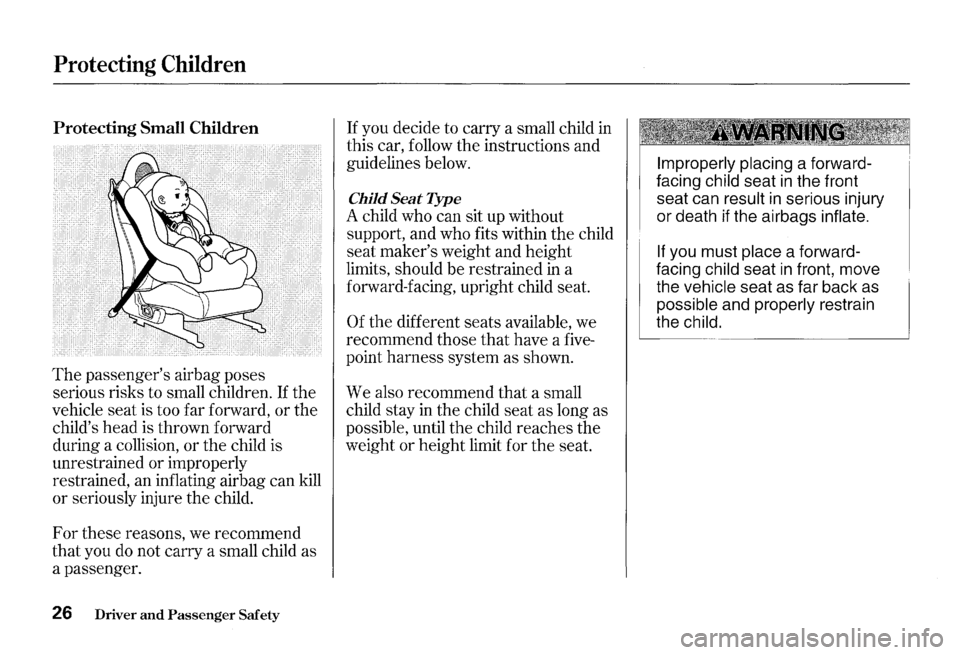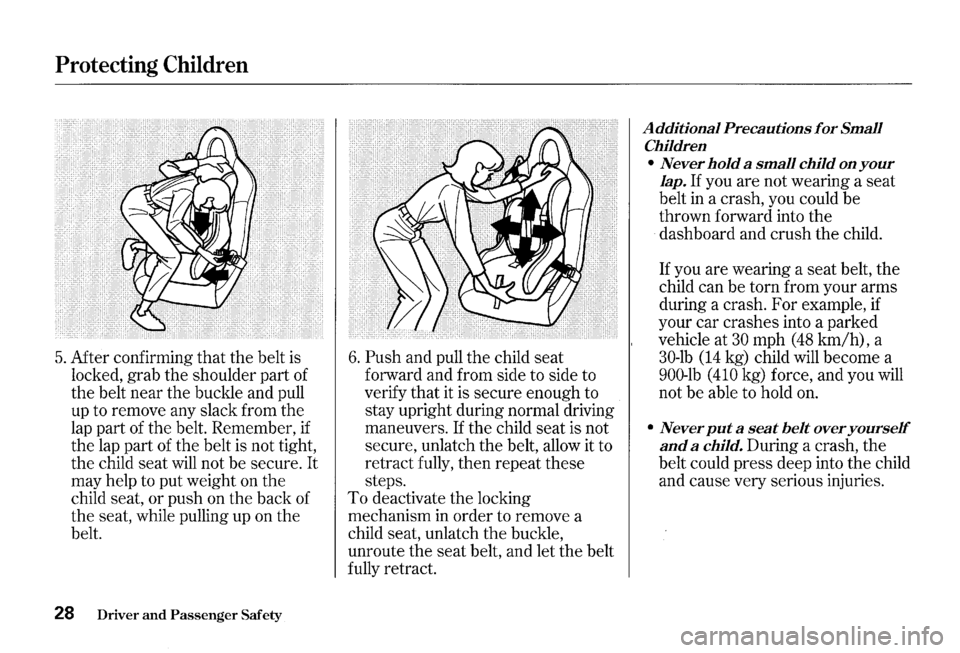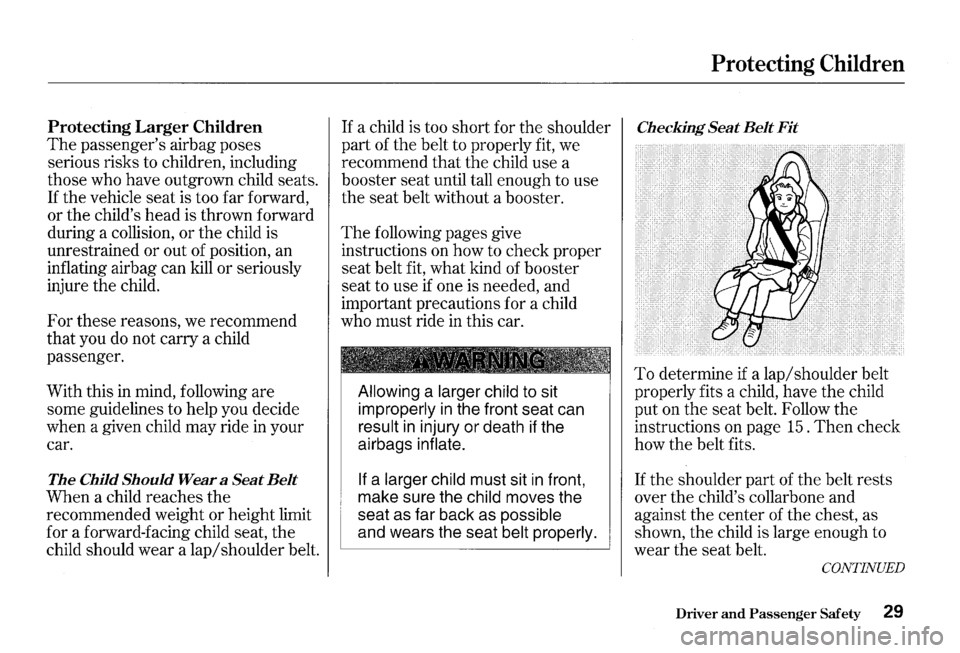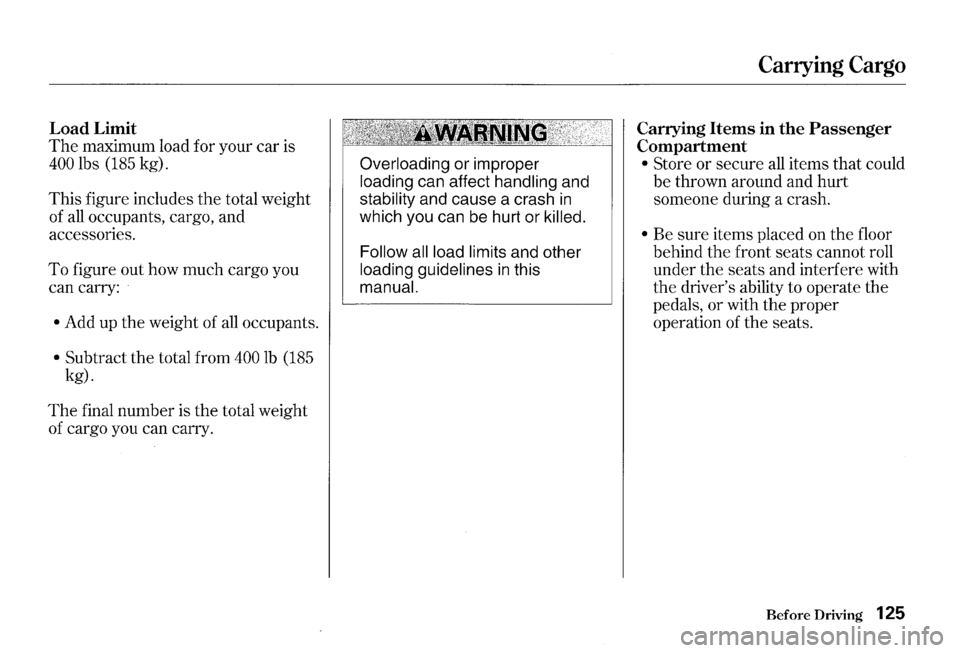2000 HONDA S2000 weight
[x] Cancel search: weightPage 29 of 273

Protecting Children
Protecting Small Children
The passenger's airbag poses
serious risks to small children.
If the
vehicle seat is too far forward, or the
child's head is thrown forward
during a collision, or
the child is
unrestrained or improperly
restrained, an inflating airbag can kill
or seriously injure the child.
For these reasons, we recommend
that you
do not carry a small child as
a passenger.
26 Driver and Passenger Safety
If you decide to carry a small child in
this car, follow the instructions and
guidelines below.
Child Seat Type
A child who can sit up without
support, and who fits within the child
seat maker's weight and height
limits, should be restrained
in a
forward-facing, upright child seat.
Of the different seats available, we
recommend those
that have a five
point harness system as shown.
We also recommend that a small
child stay
in the child seat as long as
possible, until the child reaches the
weight or height limit for the seat.
Improperly placing a forward
facing
child seat in the front
seat can
result in serious injury
or death if the airbags
inflate.
If you must place a forward
facing
child seat in front, move
the
vehicle seat as far back as
possible and properly restrain
the
child.
Page 31 of 273

Protecting Children
5. After confirming that the belt is
locked, grab the shoulder part of
the belt near the buckle and pull
up to remove any slack from the
lap part of the belt. Remember,
if
the lap part of the belt is not tight,
the child seat
will not be secure. It
may help to put weight on the
child seat, or push on the back of
the seat, while pulling up on the
belt.
28 Driver and Passenger Safety
6. Push and pull the child seat
forward and from side to side to
verify that it is secure enough to
stay upright during normal driving
maneuvers.
If the child seat is not
secure, unlatch the belt, allow it to
retract fully,
then repeat these
steps.
To deactivate the locking
mechanism
in order to remove a
child seat, unlatch
the buckle,
unroute the seat belt, and let the belt
fully retract.
Additional Precautions for Small
Children
• Never hold a small child on your
lap. If you are not wearing a seat
belt
in a crash, you could be
thrown forward into the
dashboard and crush the child.
If you are wearing a seat belt, the
child can be torn from your arms
during a crash. For example,
if
your car crashes into a parked
vehicle at
30 mph ( 48 km/h), a
30-lb (14 kg) child will become a
900-lb (410 kg) force, and you will
not be able to hold on.
• Never put a seat belt over yourself
and a child. During a crash, the
belt could press deep into the child
and cause very serious injuries.
Page 32 of 273

Protecting Larger Children
The passenger's airbag poses
serious risks to children, including
those who have outgrown child seats.
If the vehicle seat is too far forward,
or the child's head is thrown forward
during a collision, or the child is
unrestrained or out of position, an
inflating airbag can kill or seriously
injure the child.
For these reasons, we recommend
that you
do not carry a child
passenger.
With this
in mind, following are
some guidelines to help you decide
when a given child may ride in your
car.
The Child Should Wear a Seat Belt
When a child reaches the
recommended weight or height limit
for a forward-facing child seat, the
child should wear a lap/shoulder belt.
If a child is too short for the shoulder
part of the belt to properly fit, we
recommend that the child use a
booster seat until tall enough to use
the seat belt without a booster.
The following pages give
instructions on how to check proper
seat belt fit, what kind of booster
seat to use
if one is needed, and
important precautions for a child
who must ride in this car.
Allowing a larger child to sit
improperly in the front seat can
result in injury or death if the
airbags
inflate.
If
a larger child must sit in front,
make sure the
child moves the
seat as far back as
possible
and wears the seat belt properly.
Protecting Children
Checking Seat Belt Fit
To determine if a lap/shoulder belt
properly fits a child, have the child
put on the seat belt. Follow the
instructions on page 15.
Then check
how the belt fits.
If the shoulder part of the belt rests
over the child's collarbone and
against the center of the chest, as
shown, the child is large enough to
wear the seat belt.
CONTINUED
Driver and Passenger Safety 29
Page 69 of 273

Keys and Locks
Trunk
You can open the trunk in three
ways:
• Press the trunk release button in
the lower console compartment.
• Use the master key to open the
trunk lock.
The valet key does not
work in this lock.
• Press and hold the trunk release
button on the remote transmitter
for approximately one second (see
page
63 ).
66 Instruments and Controls
To close the trunk, press down on
the trunk lid.
To protect items in
the trunk when
you need to give the key to someone
else, lock the lower console
compartment with
the master key
and give
the other person the valet
key.
See page 124 for cargo loading and
weight limit information. Keep the
trunk lid closed
at all times while
driving to avoid damaging the lid,
and to prevent exhaust gas from
getting into
the interior. See Carbon
Monoxide Hazard
on page 39 .
Page 124 of 273

The condition of your car and your
driving habits are the two most
important things
that affect the fuel
mileage you get.
Car Condition
Always maintain your car according
to the maintenance schedule. This
will keep it in top operating condition.
An important part of that mainte
nance is the
Owner Maintenance
Checks
(see page 155 ). For
example, an underinflated tire
causes more
"rolling resistance,"
which uses fuel. It also wears out
faster, so check the tire pressure
at
least monthly.
In winter, the build-up of snow on
your car's underside adds weight and
rolling resistance. Frequent cleaning
helps your fuel mileage and reduces
the chance of corrosion.
Driving Habits
You can improve fuel economy by
driving moderately. Rapid acceler
ation, abrupt cornering, and hard
braking use more fuel.
Always drive
in the highest gear that
allows the engine to run and acceler
ate smoothly.
Depending on traffic conditions, try
to maintain a constant speed. Every
time you slow down and speed up,
your car uses extra fuel.
Use the
cruise control, when appropriate, to
increase fuel economy.
A cold engine uses more fuel than a
warm engine.
It is not necessary to
"warm-up" a cold engine by letting it
idle for a long time. You can drive
away
in about a minute, no matter
how cold it is outside.
The engine
will warm up faster, and you get
better fuel economy. To cut down on
the number of
"cold starts," try to
Fuel Economy
combine several short trips into one.
The air conditioning puts an extra
load on the engine which makes it
use more fuel.
Turn off the A/C to
cut down on air conditioning use.
Use the flow-through ventilation
when the outside air temperature is
moderate.
Before Driving 121
Page 127 of 273

Carrying Cargo
124 Before Driving
Your car has several convenient
storage areas so you can stow cargo
safely.
The upper and lower console
compartments are designed for small,
lightweight items.
The trunk is
intended for larger, heavier items.
However, carrying too much cargo,
or improperly storing
it, can affect
your car's handling, stability and
operation and make it unsafe. Before
carrying any type of cargo, be sure to
read the following pages.
Page 128 of 273

Load Limit
The maximum load for your car is
400 lbs (185 kg).
This figure includes
the total weight
of
all occupants, cargo, and
accessories.
To figure out how much cargo you
can carry:
• Add up the weight of all occupants.
• Subtract the total from 400 lb (185
kg).
The final number is the total weight
of cargo you can carry.
Overloading or improper
loading can affect handling and
stability and cause a crash in
which you can be hurt or killed.
Follow all load limits
and other
loading guidelines in this
manual.
Carrying Cargo
Carrying Items in the Passenger
Compartment
• Store or secure all items that could
be thrown around and
hurt
someone during a crash.
• Be sure items placed on the floor
behind the front seats cannot roll
under the seats and interfere with
the driver's ability to operate the
pedals, or with the proper
operation of the seats.
Before Driving 125
Page 161 of 273

Engine Oil
The oil container may also display
the
API Certification seal. Make sure
it says
"For Gasoline Engines."
158 Maintenance
The SAE numbers tell you the oil's
viscosity or weight. Select the
oil for
your car according to this chart.
60
. 10 20
" ~ c" ' -c '
AnlbielltTertlperature
An oil with a viscosity of lOW-30 is
preferred for improved fuel economy
and year-round protection in your
Honda.
You may use a 5W-40 oil if
the temperature in your area goes
below oaF (
-20°C).
Synthetic Oil
You may use a synthetic motor oil if
it meets the same requirements
given for conventional motor
oil:
energy conserving, a service
classification of
SJ, and the proper
weight as shown on the chart. When
using synthetic
oil, you must follow
the
oil and filter change intervals
given
in the maintenance schedule.
Additives
Your Honda does not need any oil
additives. Purchasing additives for
the engine or transmission will not
increase your car's performance or
longevity.
It only increases the cost
of operating your car.